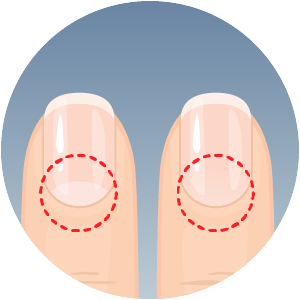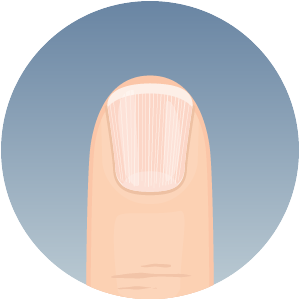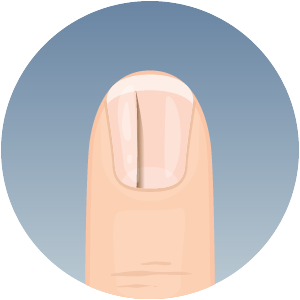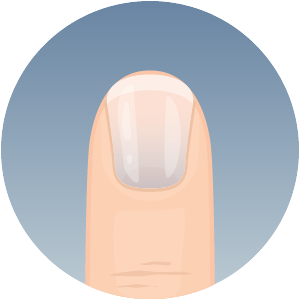Healthy Living
Nail it! Health Problems Fingernails Can Reveal
 |  |  |  |
Your nails are a unique window to what goes inside your body. The nail shape and texture can be signs of potential medical conditions, including liver, lung and heart problems. Healthy nails are shiny and smooth with a visible pink nail bed and a slight curve on the white free margin. They are not cracked, rigid or broken; they are uniform in color and consistency and without spots or discoloration. Learn what your nails' color, shape and texture tell you about your health.
The lunula is the white half-moon shape found at the base of the nail just above the cuticle. An extended lunula, making the majority of the nails white in color except for a narrow band at the top, could signal cirrhosis, chronic renal failure or congestive heart failure. Having a blueish tint in the lunula could mean Wilson's disease, a rare inherited genetic disorder characterized by the accumulation of copper in the liver, brain and other organs. In contrast, a red lunula could indicate heart failure.
Changes in nail shape and texture
Nails that are dimpled or pitted may indicate psoriasis, a chronic skin disease characterized by scaly and inflamed skin patches on the scalp, elbows or knees. Psoriasis and thyroid disease can cause the nails to loosen and separate from the nail bed. Iron deficiency or overproduction may cause the nail bed's center to look like it had been scooped out, a condition known as spoon nails. Cardiovascular, pulmonary and gastrointestinal problems may also appear in the nails as curves around an enlarged fingertip, known as clubbing.
Lines on the nails
A dark-colored streak that runs the length of the nail or on or around the fingernail could mean melanoma, the deadliest form of skin cancer. Unfortunately, melanoma does not usually have noticeable symptoms, and the color of the nail may be the only indication of this disease.
An indented horizontal line on the nails (called Beaus' lines) could signify a previous serious illness, injury or shock to the body that caused the nails to stop growing temporarily. Beaus' lines may also be a sign of uncontrolled diabetes, the result of cancer treatment or, in patients with Raynaud's disease, a consequence of exposure to cold temperatures.
Changes in color
A blue hue in the nails may mean low oxygen levels in the blood, which is a warning sign of COVID-19. Yellowish nails may indicate chronic bronchitis and other lung diseases or fungal infections. However, this is more common in toenails than fingernails, while nails that appear white (a condition called Terry's nails) may be a sign of liver, kidney or heart problems.
In conclusion
Not all changes to the nail are bad. Some are completely harmless, while some are normal signs of aging or maybe a side effect of a medication. However, if you think there is something amiss with the texture and color of your nails and experience other symptoms, such as fatigue, shortness of breath or stomach pain, consult a healthcare provider or go to the nearest emergency room. We're here for you, always.
Sources:
American Association of Retired Persons
National Center for Biotechnology Information



